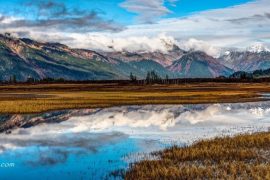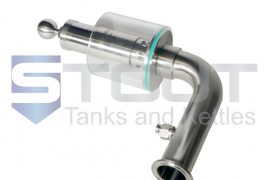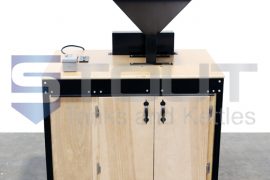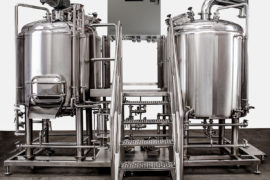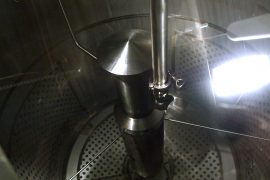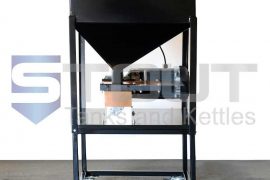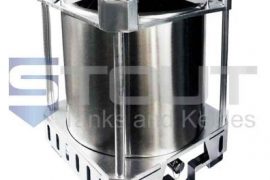PLEASE NOTE: The procedures in this document are generalized to cover a wide range of cleaning demands around the brewhouse.
CLEANING MODERN BREWERIES
Brewers should regularly and thoroughly clean their brewhouse and brewing equipment for many reasons. Proper cleaning and sanitization will prevent the transfer of flavors and odors from one batch of product to another, prolong the usefulness of equipment, ensure efficient operation, and eliminate contamination.
Cleaning and sanitizing are distinct processes that are essential to brewhouse upkeep. Without prior cleaning, the residual biofilm will interfere with the sanitizers and potentially neutralize their effectiveness. Likewise, without adequate sanitization, microorganisms are likely to grow and be introduced to your products.
T.A.C.T. This simple acronym will help you to remember good cleaning practices.
T – Time. The amount of time a cleaning agent remains in contact with the soil/biofilm determines the effectiveness of your cleanup. Too long and you are wasting time. Too short and you are not removing potential contaminants. During the brewing process, it is almost always easier to remove soil deposits while they are still fresh.
A – Action. From CIP spray balls to manual scrubbing, there are many factors to consider when applying your cleaner. From brush texture, to flow rate, to foaming, to gel, to burst rinsing, the action you are performing will depend largely on the chemical being used and the equipment being cleaned.
C – Cleaner/Concentration. Different chemicals are effective against different types of brewhouse biofilms. It will make your cleaning easier if you understand the soils you are removing and protecting against. Likewise, the ratio of water to chemical is crucial to successful sanitization. Measure twice, pour once.
T – Temperature. For every increase of 10ºF in your solution, the number of molecule collisions is roughly doubled. The hotter the cleaning solution, the more cleaning can be achieved. But other factors such as the chemicals in use and the equipment being cleaned also play a factor in determining proper temperature. Make sure you are paying close attention to the temperature warnings of your cleaning agents and equipment.
PASSIVATION BASICS
When does your equipment need to be passivated?
Corrosion resistance of the nickel-chromium steels (ANSI class 300 series) depends upon the formation of a protective chromium oxide film. These films can be damaged during fabrication and through careless handling. When the film is damaged the stainless surface is susceptible to corrosion and pitting. The passive surface is corrosion resistant and needs to be maintained to prolong the life of the stainless steel.
New stainless steel should always be cleaned and passivated to remove the cutting and milling oils and establish a passive oxide layer. We recommend passivating tanks and line circuits every other year to reduce the probability of corrosion.
Passivation of a stainless steel surface occurs naturally by air, but it is a slow process. Use chemicals like nitric acid(CS35) to accelerate the process.
3 Basic Steps for Passivating:
Neither air nor nitric acid can form a protective film when grease, oil, fingerprints, or other contaminants are present on the surface of the tanks. To ensure the surface is degreased you must first perform a water break test:
- Degreasing/Cleaning
- Use a water based high pressure solvent(CS109) and mix 2 oz/gallon.
- Circulate at 140ºF for 30 minutes.
- Rinse with fresh water
- Passivation
- Prepare a 6% weight per weight (w/w) citric acid solution in the vessel.
- Calculate solution
- (CIP volume of tank in gallons) * (8.34 lb) = Y
- (Y) * (0.060) = X lbs of Citric Acid
- PH of solution should be less than 4
- Circulate citric acid solution for 60 min at 140ºF
- To maintain temperature, run CIP loop through heat exchanger or steam jacketed kettle
- Drain system and rinse with water for 5 minutes
- Check pH of rinse water. Should match supply tap.
- Open all ports and allow system to air dry for 48 hours.
- Sanitizing
- Rinse with cold water.
- Mix a solution of peracetic acid(CS513) and cold water 0.4 oz/gallon.
- Circulate for 30 min.
- Do not rinse.
TANK INTERIORS
Hot Liquor Tanks
“Scaling” inside an HLT is caused by a buildup of phosphoric acid/calcium on the tank walls. These compounds can be introduced through the water system (hard water) or as an additive. Some brewers introduce phosphoric acid or calcium to their HLT to adjust the pH before mashing, but in order to avoid scaling on your HLT we recommend adding these components directly to your mash instead of the hot liquor tank.
- Mix a phosphoric acid(CS15) solution to clean or descale your HLT.
- Fill tank to 10% volume with water. Add 1 oz/gallon water.
- Heat solution to 150ºF and circulate for 30 minutes.
- If tank is free from scaling:
- Rinse with warm fresh water.
- If tank still has scale:
- Check pH of solution.
- If pH is above 4.0 and the solution looks clear (fully dissolved) add more phosphoric.
- Bring the pH down to 2.0 and CIP again.
Brewing Tanks (Mash tun, lauter tun, brew kettle, whirlpool, hot wort tank)
- Knockout (turn off the heat source).
- Pre-rinse with water and drain thoroughly. Repeat 2 or 3 times, burst rinsing is most effective.
- If there is Beerstone scale present (calcium oxalate):
- Add beer stone and milk stone remover(CS122) at normal use rates.
- Heat to 190ºF and cycle for 45 minutes.
- Drain tank. This solution can be reused on similar tanks within the same day.
- Detergent wash with suitable caustic(CS20) or alkaline cleaner(CS464):
- Mix 1-2 oz/gallon.
- Heat to 160-180ºF and circulate for 30 minutes.
- Drain out detergent solution. This same solution can be used to CIP your fermenters and brite tanks.
- Chase with warm water. Do not allow tank surfaces to dry.
- Continue to burst rinse and check pH until alkali is gone.
Storage Tanks (Fermenters, Brite Tanks, Serving Tanks)
So long as you can circulate hot water, 180ºF, through your storage tanks then you may use the same caustic or alkaline CIP solution from the brewing tanks. Simply circulate for 30 minutes then rinse with fresh water until pH is restored.
If it is hard to heat these tanks, then use an alkaline solution(CS17):
- Remove CO2 and perform burst rinses of tank using cold water.
- Fill tank to 10% capacity with warm water
- Mix 1-2 oz/gallon. Circulate for 30 minutes.
- Drain solution and rinse tank until pH of water is restored.
- Drain and seal tanks.
LINE AND HEAT EXCHANGERS
The solutions used to clean the tanks may be conveniently circulated through lines and heat exchangers, followed by the appropriate rinsing and acid washing where necessary.
NOTE: For this system to be completely successful, recirculation will be necessary to achieve appropriate contact time (around 45 minutes) in the detergent wash step of the system.
If clean-out-of-place is used, a manual chlorinated cleaner should be used, followed by appropriate rinsing and sanitizing before reassembly of the plant.
In cases where build-up of mineral occurs in the tubing, acid wash may be required on occasion to aid in the removal of this “soil” – again followed by an appropriate rinsing and sanitizing before reassembly. Learn more about this >
Beer & Milk Stone Remover can be added to caustic to help remove beer stone.
Phos/NITRIC ACID CIP CLEANING
It is important to periodically circulate phos/nitric acid solution through your tanks, lines, and heat exchangers to remove stains and mineral films. We recommend performing this cleaning after every other brewing run.
- After alkaline cleaner application, rinse surfaces with water
- Add acid CIP cleaner(CS35) at 1-2 oz/gallon.
- Heat to 145ºF and circulate 30 minutes.
- Burst rinse surfaces thoroughly with hot, potable water.
TANK EXTERIORS AND OTHER SURFACES
The best way to control mold, mildew and yeast growth on brewhouse surfaces is to clean with a foaming chlorinated cleaner such as Foaming Chlorinated Cleaner(CS12).
Do not use this product on copper surfaces. Be sure to rinse well.
Sanitize afterword with PAA(CS513) or quaternary ammonium disinfectant(Sani 512).
BIG Thank You to ENERCO Brewery Cleaners for helping us put this document together.
Have a Question? We are here to help. Contact Us Now >

